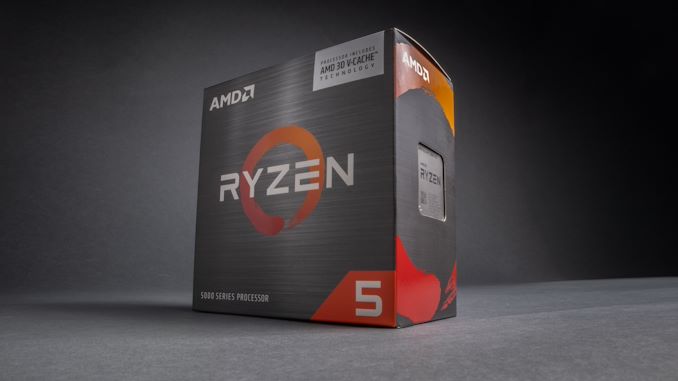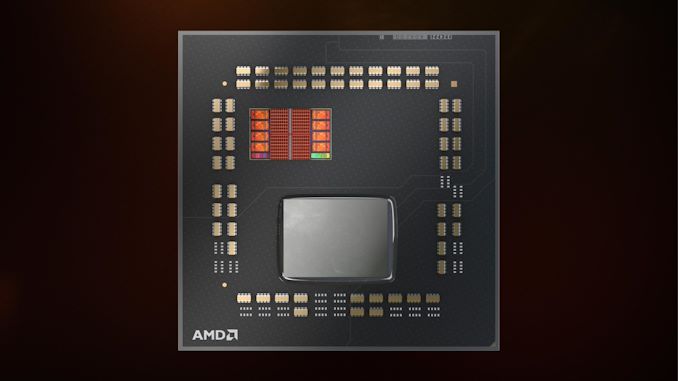AMD To Release Limited Run Ryzen 5 5600X3D for $230, Micro Center Exclusive
by Ryan Smith on July 1, 2023 10:00 AM EST
With AMD now several months post release of their current AM5 platform, I figured that the sun was setting on AMD’s previous-generation AM4 platform. But, it would seem, AM4 is going to get one last hurrah, as AMD is preparing to release a new chip for the platform: a V-cache equipped, hex-core Ryzen 5 5600X. And while the chip itself is notable in a couple of ways, what’s likely going to end up better remembered is the unusual launch of the chip, with it being released as a limited edition Micro Center exclusive on July 7th.
First things first, let’s start with the chip itself. The Ryzen 5 5600X3D is a 6 core Zen 3 processor with AMD’s 64MB V-cache die stacked on top, giving the Zen 3-era chip a total of 96MB of L3 cache. Architecturally, it’s a lower-bin SKU of the same silicon AMD uses to make their existing 5800X3D, just running at marginally lower clockspeeds and with two CPU cores fused off. In practice, this is a salvage part to make use of Zen 3 CCDs with minor defects, just like the regular Ryzen 5 5600X.
| AMD Ryzen 7000/5000 X3D Chips | ||||||||
| AnandTech | Cores Threads |
Base Freq |
Turbo Freq |
Memory Support |
L3 Cache |
TDP | PPT | Price (MC) |
| Ryzen 9 7950X3D | 16C / 32T | 4.2 GHz | 5.7 GHz | DDR5-5200 | 128 MB | 120W | 162W | $628 |
| Ryzen 9 7900X3D | 12C / 24T | 4.4 GHz | 5.6 GHz | DDR5-5200 | 128 MB | 120W | 162W | $520 |
| Ryzen 7 7800X3D | 8C / 16T | 4.2 GHz | 5.0 GHz | DDR5-5200 | 96 MB | 120W | 162W | $420 |
| Ryzen 7 5800X3D | 8C / 16T | 3.4 GHz | 4.5 GHz | DDR4-3200 | 96 MB | 105W | 142W | $280 |
| Ryzen 5 5600X3D | 6C /12T | 3.3 GHz | 4.4 GHz | DDR4-3200 | 96 MB | 105W | 142W | $230 |
| Ryzen 5 5600X | 6C /12T | 3.7 GHz | 4.6 GHz | DDR4-3200 | 32 MB | 65W | 88W | $148 |
With regards to the processor’s specifications, it looks pretty much exactly like what you’d expect for a Ryzen 5 X3D part. The base clockspeed of 3.3GHz and boost clockspeed of 4.4GHz are a step below the full Ryzen 7 5800X3D, and along with the loss of 2 CPUs cores, the chip is taking a modest hit to CPU throughput. However, because disabling two CPU cores doesn’t disable any of the L3 cache within AMD’s Zen 3 CCD, the chip still has all of its 96MB of L3 cache available – making this the lowest-end AMD part to get a supersized L3 cache pool.
Otherwise, the rest of the official specs are the same as the 5800X3D that this lesser chip is cut from. That means power consumption is rated for a TDP of 105W (142W PPT), which is in-line with most of the rest of the Ryzen 5000X family, though it is a tier higher than the 65W TDP of the 5600X that it will be sitting next to within AMD’s product stack. And, lest anyone has forgotten following the Ryzen 7000 launch, as this is a Zen 3 desktop CPU only DDR4 memory is supported, and there isn’t an integrated GPU of any kind.
While there’s nothing particularly unusual about AMD releasing a salvage part to fill in a spot in their product lineup, AMD’s decision to release this so late into AM4’s lifecycle – after the Ryzen 5000X3D family’s successors are already released – does stand out. Although AMD is taking an unusually distant approach to this launch (more on that in a second), all signs point to AMD opting to offload the relatively small number of defective chips that they have amassed over the past year as part of 5800X3D production.
Because AMD does not have any current Ryzen 5000X3D chip SKUs with 6 CPU cores, and the 5800X3D requires a “perfect” Zen 3 + V-cache die, AMD hasn’t had an outlet for chips that fail to make the grade. On larger run products like the regular Ryzen 5000 family, this would be accounted for from the start with parts like the 5600X, but the V-cache Ryzen 5000X3D family is produced in relatively small numbers to begin with, so there aren’t a lot of defective-but-salvageable chips sitting around (most of the duds would be a bad connection between the CCD and v-cache die, we reckon). Still, if you produce something like the 5800X3D for long enough, those defective chips do start stacking up. So AMD’s options are to either dispose of them, or to make a profit out of them – and thus we get the Ryzen 5 5600X3D.
Hardware-wise, I’m a bit surprised to see that AMD has enough of these harvested chips to even bother with a salvage run. The intricate die stacking required to place a V-cache die on a CCD means that there’s no reason AMD should be placing the cache on anything less than a perfect, 8 core Zen 3 CCD. Still, it would seem that either the CCD validation process or the stacking process is imprecise enough that a few less-than-perfect parts still make it through the cracks. And hey, it makes for some good conversational hardware.
In any case, the low volume of the Ryzen 5 5600X3D means that it doesn’t necessarily have to be a competitive chip over the long haul of the market; it only needs to sell out once. And with a price tag of $229.99, it shouldn’t have too much trouble doing so. At this price it’s $50 below the 5800X3D and some $82 more expensive than the vanilla 5600X, which is similar to the premium for the 5800X3D over its regular counterpart.
As with the 5800X3D, what will make or break the chip are those workloads that can make use of the chip’s expansive 96MB of L3 cache. Which for the consumer market has primarily been games. For those games that benefit from the large L3 cache size – and have been the reason du jure to get the 5800X3D up until now – the 96MB of L3 cache in the even cheaper 5600X3D makes for an interesting and potentially performative alternative – at least so long as that workload won’t greatly miss the two disabled CPU cores.
Otherwise, the second most convincing use case for the short stocked chip will be as an upgrade for existing AM4 systems. It won’t be a halo upgrade part like the 5800X3D, but if your workloads benefit enough to justify getting an X3D chip over a cheaper vanilla processor, it’s another option to consider.
Ryzen 5 5600X3D: A Limited Volume, Micro Center Exclusive
But what’s perhaps most interesting about this launch is not what’s being launched, but whom it’s being launched with. As noted earlier, this is a low volume part – so low that a traditional global launch is seemingly out of the question. So rather than releasing the part worldwide with hundreds of partner retailers, AMD is partnering with just a single company to release it in a single region: Micro Center.
The beloved brick and mortar PC parts retailer will be the only store receiving the Ryzen 5 5600X3D. And indeed, while this is an AMD chip, it’s very much Micro Center’s launch. AMD isn’t promoting the processor or even issuing any press releases; all of that is being handled by Micro Center. It’s about as exclusive as a processor launch can get, short of a retailer requisitioning their own chip SKU.
The exclusive launch with Micro Center means that, among other things, this is a de facto US-only part. Regional rarities are not unheard of (AMD and Intel have been known to launch China-only parts now and then), but it’s less common to get something that’s US-only. Meanwhile, even if you’re in the US, you’ll need access to a Micro Center store to get the chip. The company’s retail footprint is limited, with just 25 stores, primarily in the mid-west and east. So even in AMD’s own backyard of Austin, Texas, the 5600X3D technically isn’t available.
Above all else, the exclusivity of the launch underscores the limited number of chips that will be available. While neither Micro Center nor AMD are disclosing the total number of chips being made available, if a mid-sized retailer like Micro Center can move enough chips to use up whatever AMD is supplying, then we’re looking at a very small number compared to the typically massive global launch. Still, our colleagues over at Tom's Hardware report that Micro Center has told them that they expect to have "several months of availability," so it's also not necessarily a product that will sell out forever on its first day.
In any case, Micro Center will be selling the chip alone, as well as part of a couple of different bundles. The solo chip will be $230, and like its 5800X3D counterpart, is sold chip-only, without a bundled cooler. Meanwhile, Micro Center will also be offering a $330 bundle that pairs the chip with ASUS’s B550-PLUS TUF Gaming Motherboard and 16GB of G.Skill Ripjaws V DDR4 memory. Finally, the store will be offering a full-on prebuilt system as well, the PowerSpec G516, which will round out the collection with a Radeon RX 6650 XT and a 500GB SSD for $850. All three options will go on sale on July 7th.












39 Comments
View All Comments
Nfarce - Thursday, July 13, 2023 - link
Atlanta has two locations in exhurb cities northwest (Marietta) and northeast (Duluth) of downtown.eastcoast_pete - Saturday, July 1, 2023 - link
I am a bit confused by this. I thought the 3D VCache is added right on top of the chiplet die, but is the same size also for the 7000 chiplets. So I guess the 3D VCache is added after they identify bad cores in "5800" and fuse them off to make 5600s. But then, why use 3D Cache for the old line of 5600 Ryzens? Do TSMC/AMD have now VCache dies to spare for that? Wouldn't it make more sense to use those to increase the number of 7000er Ryzens with 3D Cache and maybe sell a few more of those? Well, I obviously don't know, and someone at AMD has probably done the math. Still puzzling, though.GreenReaper - Sunday, July 2, 2023 - link
The cache reduces maximum speed and you can't really overclock it, either. Sure, it's great for some games, but only if you're CPU-limited, and GPU is more likely to be the issue.Thunder 57 - Sunday, July 2, 2023 - link
Agreed. I'd take the considerably cheaper 5700X any day. It only makes sense as a combo. $100 more for a motherboard and 16GB of RAM? That is appealing.GreenReaper - Monday, July 3, 2023 - link
That's how I ended up with my 7600 with a B650E-I. Good deal at the time! And frankly, as much as I need and can cool, although a 7900 would perhaps have been more efficient. A proper APU would be even better - 2 CU RDNA2 works, but at a max of 1080p for older games and less for newer ones. Since the IO die is separate it doesn't take too much away from the cores.Hul8 - Monday, July 3, 2023 - link
You have the events and reasoning slightly out of order. AMD didn't set out to make this product. These last couple of years they just ended up with a number of 3D V-Cache CCDs that were only suitable for a product such as the 5600X3D.*
The entire reason 3D V-Cache was conceived and why it's produced is EPYC.
All CCDs that get stacked 3D V-Cache would start out as candidates to become parts in a server CPU.
Testing will reveal some that don't make the cut, so AMD sets them aside for gaming CPUs instead.
Zen 3 with V-Cache must have been in production since at least fall of 2021; Milan-X became available to selected customers (including Azure) in November 2021, and generally in March 2022. They've had all that time to accrue dies unsuitable for both EPYC and the 5800X3D.
Besides the 7000X3D series (and the equivalent Zen 4 EPYC Genoa-X) not being around then, those use 2nd generation 3D V-Cache that is a different die with slightly smaller footprint.
kkilobyte - Sunday, July 2, 2023 - link
"Brick and motor PC part retailer" <== Shouldn't this be a "Brick and mortar" one? Or maybe they're selling computers and cars? :PThreska - Sunday, July 2, 2023 - link
Maybe someone is thinking of that Bill Gates quote.https://www-users.york.ac.uk/~ss44/joke/crash.htm
TheinsanegamerN - Monday, July 3, 2023 - link
Brick and Motor sounds like some old english pub.abufrejoval - Tuesday, July 4, 2023 - link
I agree it's likely all about selling out left-over inventory.They must have left-over V-cache chiplets and they may have run out of perfect 8 core CCD base chips to create 3D variants, so they use 6 core leftovers.
All of these are most likely inventory, produced long ago, nothing fresh from the fabs. And they must do something before the packaging pipelines are being disassembled for that generation.
Of course they might have preferred to put those V-cache chiplets on EPYCs, but while 6-core based EPYCs might sell, V-cache 6 core variants may be too small a niche to sell.
Also hyperscalers and HPC need to focus on the newest parts, so consumer chips is the only way to empty the inventory.
The iGPU-less Ryzens are also typical end-of-life chips from wafer edge partials and they are being sold currently, too.